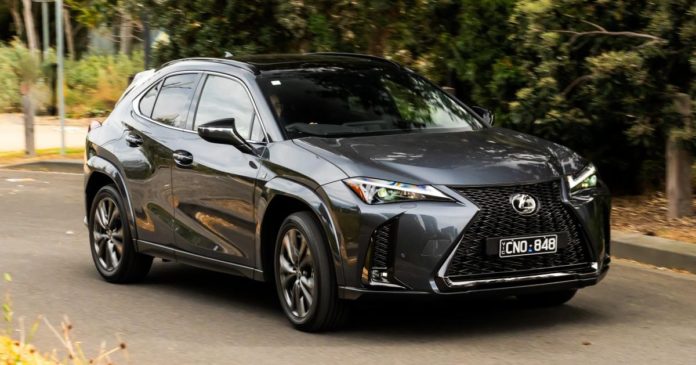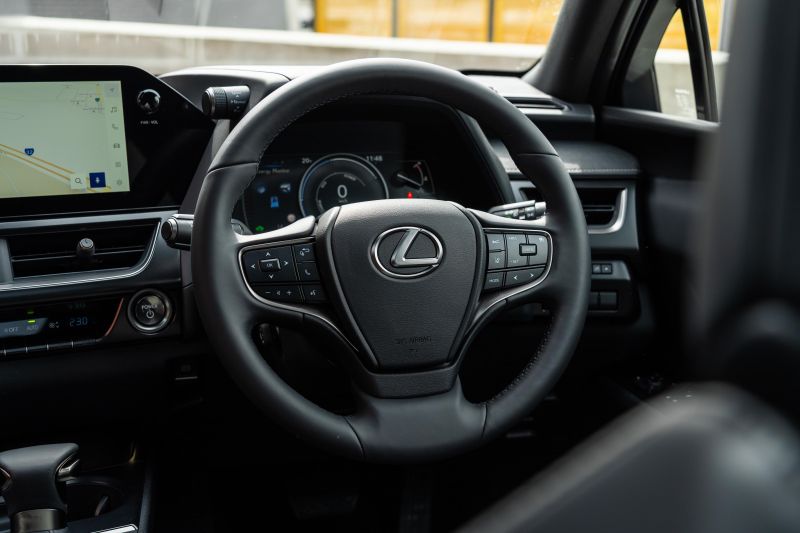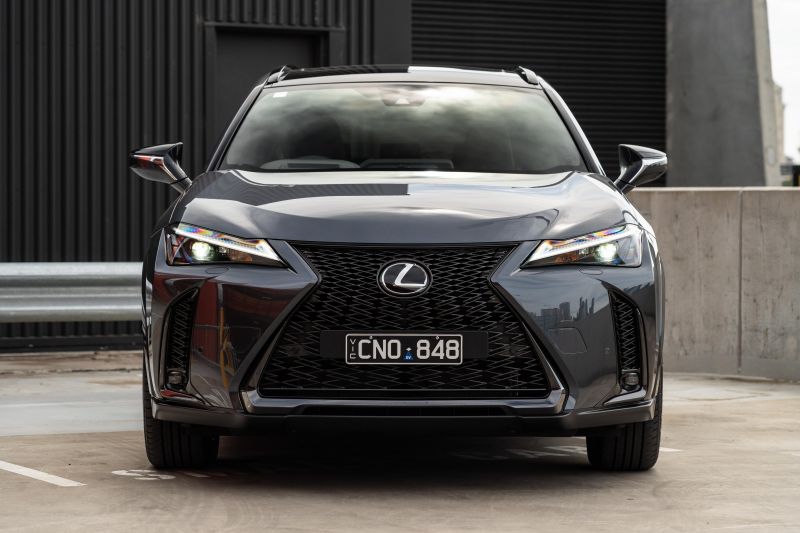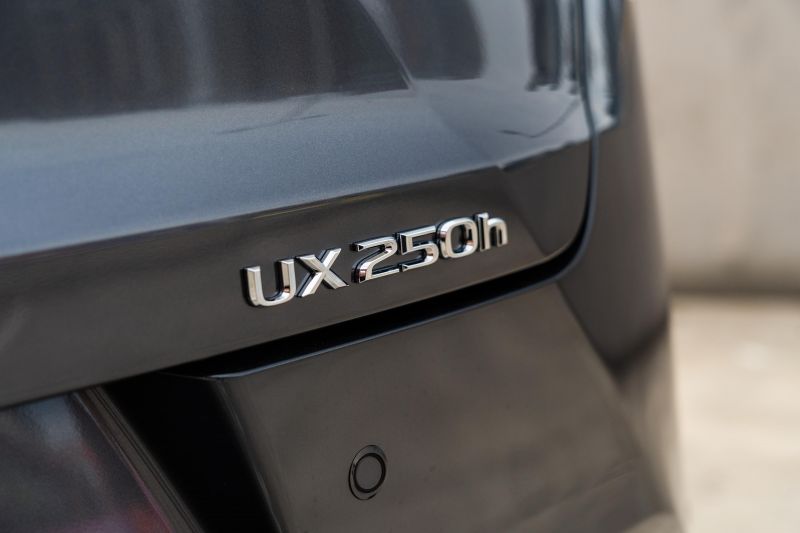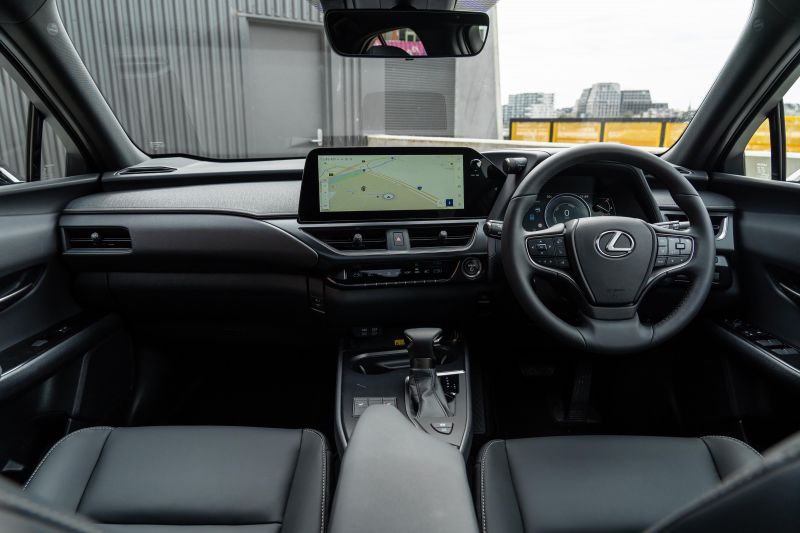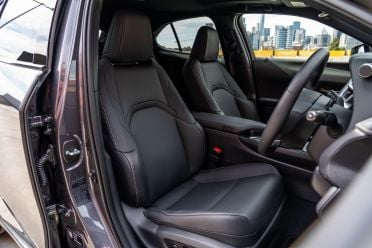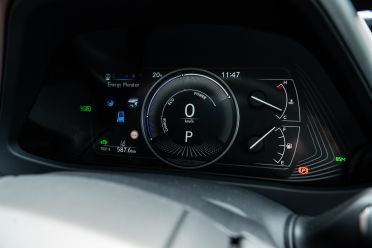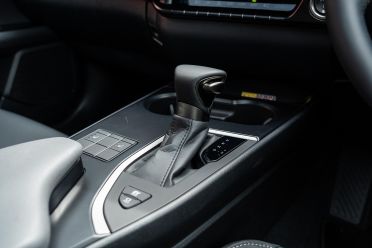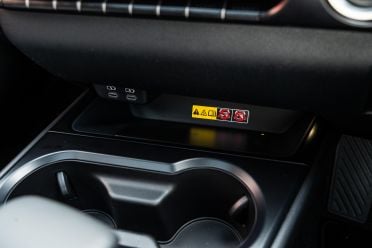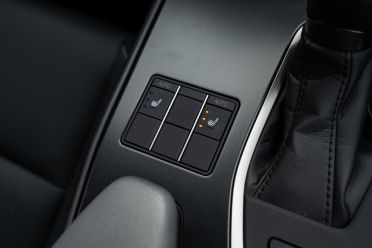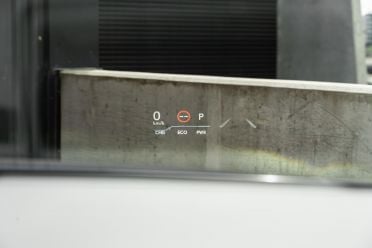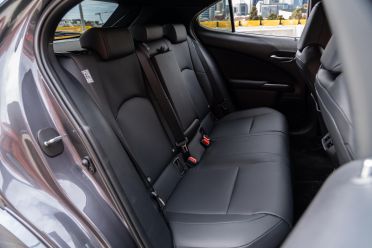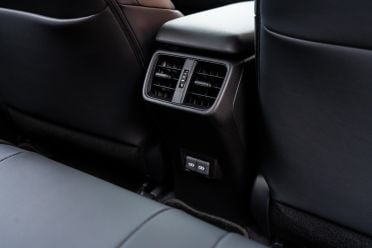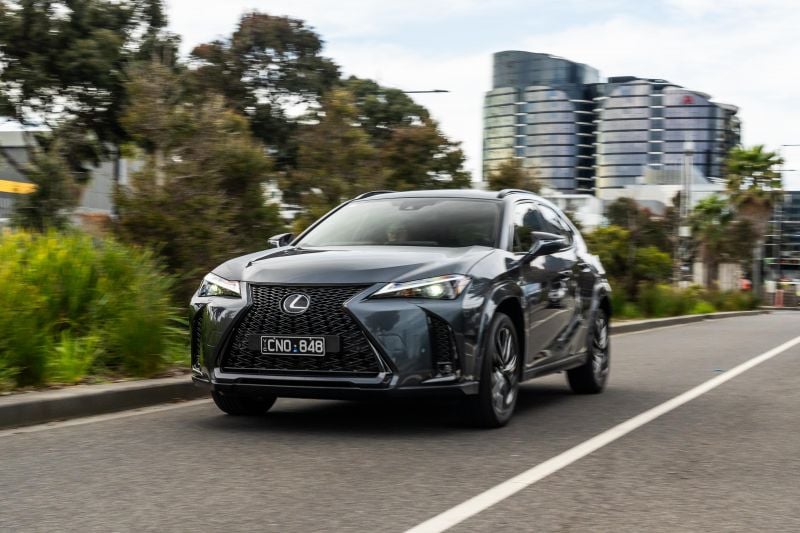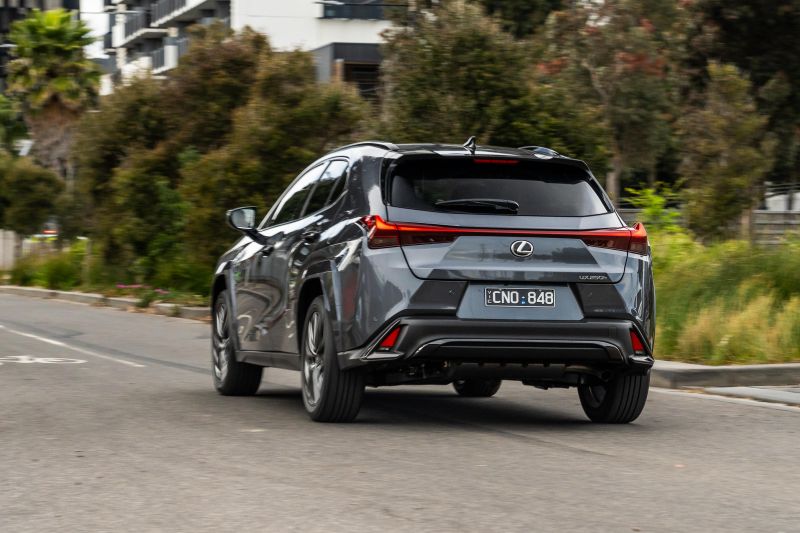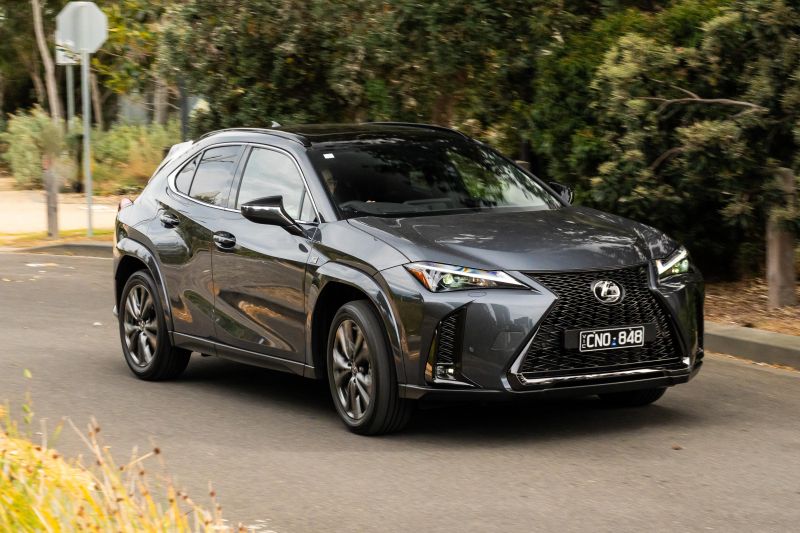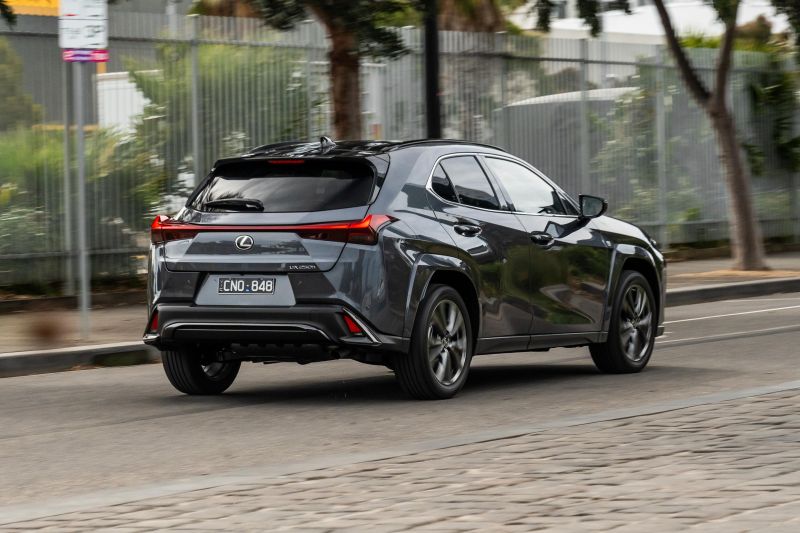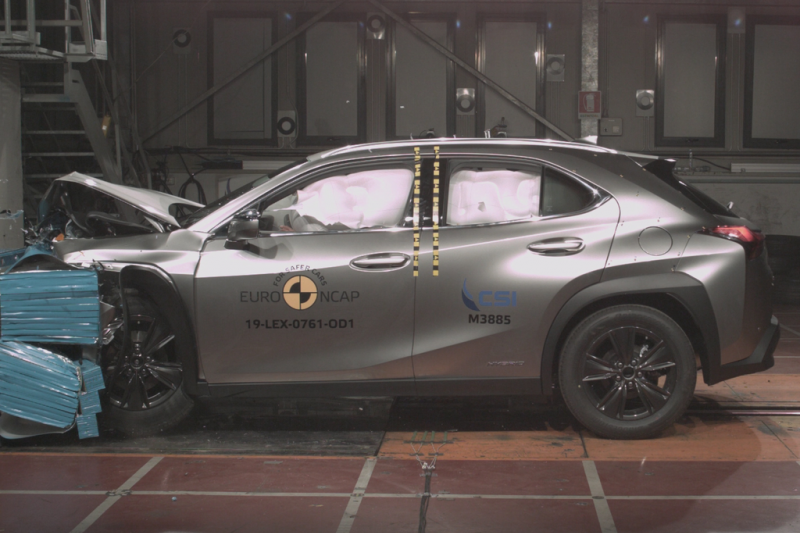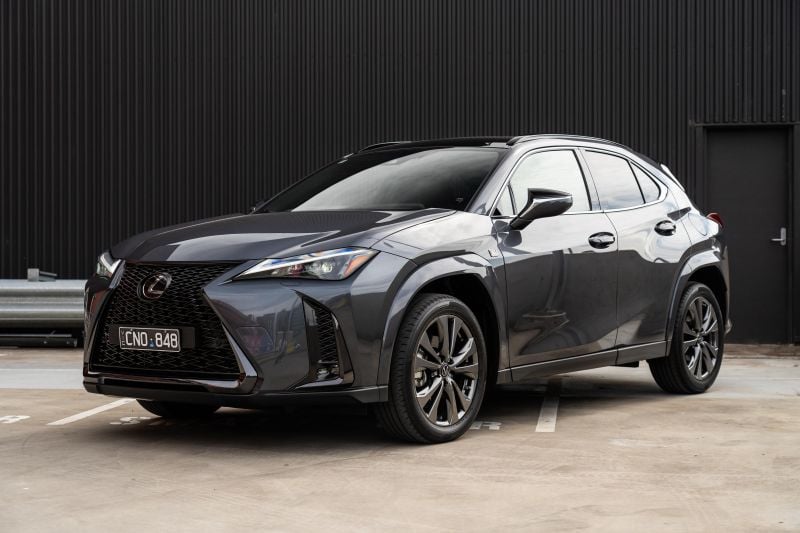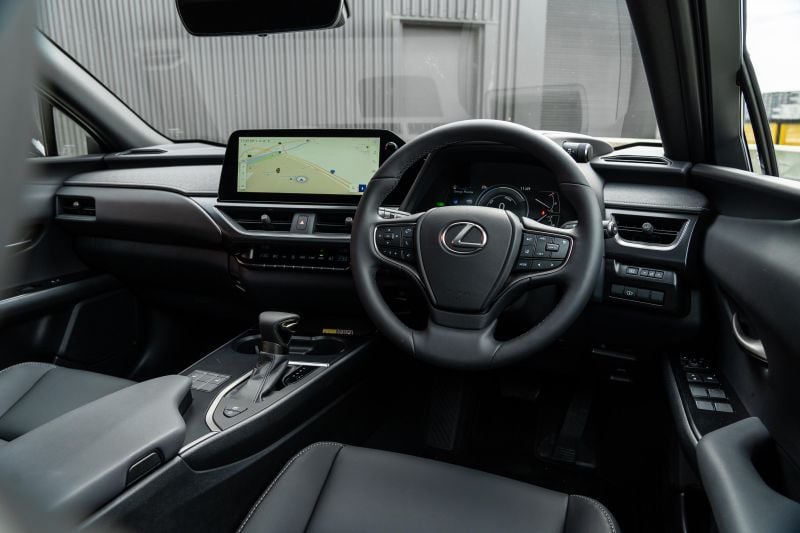This might soon be one of the rarest Lexus UX models ever offered in Australia.
Earlier this year Lexus Australia announced just 250 examples of the Lexus UX 250 h F Sport Design Special Edition are coming Down Under.
This limited-edition UX variant is based on the entry-level Luxury and comes with a range of features that make it look like an F Sport. Some of these features include a body-coloured wheel arches, F Sport badging and 18-inch alloy wheels with run-flat tyres.
There’s also black roof rails, side mirror caps, as well as a contrast-painted roof. The latter of these features is a first for the UX.
The Lexus UX has been around for a few years now – it launched locally in 2018 – and pioneered series-parallel hybrid technology in the premium small SUV segment.
A number of European rivals has since introduced mild-hybrid, plug-in hybrid, or all-electric powertrains.
Does the Lexus UX still form as an attractive small SUV offering? Read along to find out.
How does the Lexus UX fare vs its competitors?
View a detailed breakdown of the Lexus UX against similarly sized vehicles.

Lexus
UX
How much does the Lexus UX 250h cost?
The 2024 Lexus UX range starts from $46,085 before on-road costs for the UX 200 Luxury.
The UX 250h F Sport Design Special Edition on test here is around $12,500 more expensive than the entry-level variant at $58,620 before on-road costs. Our tester was finished in Sonic Chrome metallic which adds an extra $1750, bringing the total to $60,370 before on-roads.
In terms of competitors, the Lexus UX 250h F Sport Design Special Edition is priced similarly to the following:
All prices are before on-road costs.
2024 Lexus UX pricing:
- Lexus UX 200 Luxury: $46,085
- Lexus UX 250h Luxury + Enhancement Pack 2: $54,320
- Lexus UX 200 Sports Luxury: $56,850
- Lexus UX 200 F Sport: $57,495
- Lexus UX 250h F Sport Design Special Edition: $58,620
- Lexus UX 250h Sports Luxury: $61,350
- Lexus UX 250h F Sport: $61,995
- Lexus UX 250h Sports Luxury AWD: $65,850
- Lexus UX 250h F Sport AWD: $66,495
- Lexus UX 300e Luxury: $79,990
- Lexus UX 300e Sports Luxury: $87,665
Prices are before on-road costs
What is the Lexus UX 250h like on the inside?
Walking up to the Lexus UX 250h F Sport Design Special Edition and unlocking it provides you with a familiar sound that’s shared across a number of Lexus and Toyota models. If you know, you know.
Thanks in part to the raised ride height, ingress and egress in the UX is super easy as you don’t need to step up or down.
The UX 250h F Sport Design Special Edition comes as standard with NuLuxe upholstery which is essentially Lexus-speak for artificial leather. It’s really soft and feels divine, at least to me. It can be had in either Black or White Ash, with our tester featuring the former.
In addition to the seats feeling soft to the touch, the driver’s seat is super comfortable with plenty of side bolstering to hold you in place. I appreciated the amount of thigh adjustment there was as well.
Ahead of the driver is a thick, squidgy leather-wrapped steering wheel that’s similar to virtually every other Lexus model from the last few years. The only difference this steering wheel has when compared to an ES, for example, is it misses out on the wooden accents.
The steering wheel push buttons have a slightly spongey action which when pushed don’t feel very precise. As an example, you have to push the volume buttons in a particular spot for it to actually register, which can be a little frustrating.
Behind the steering wheel is where you start see this special edition is essentially a dressed-up base model as it receives the basic 7.0-inch digital instrument cluster, instead of the larger and more sophisticated 8.0-inch unit.
This 7.0-inch digital instrument cluster looks dated and a little low-resolution. It also misses out on the cool moving circular element that proper F Sport variant receives.
The entire left-hand side of this digital instrument cluster looks like it has been taken directly from any other low-end Toyota. This isn’t really fitting in a Lexus that’s $60,000.
On the flip side, the new 12.3-inch touchscreen infotainment system is one of the updated Lexus UX’s best features.
This new unit is very high-resolution and has heaps of processing power. This means the infotainment system starts up quickly when you start the car, and new content loads snappily.
The new infotainment system now supports wireless Apple CarPlay, while Android Auto is still only available in wired form.
Throughout my time with the tester I exclusively used wireless Apple CarPlay, which worked flawlessly apart from one trip home where it just outright refused to acknowledge that my phone was connected.
To keep my phone battery topped up while using wireless CarPlay there’s thankfully a wireless phone charger that I was surprised to see actually charge my phone. A lot of cars I drive with wireless chargers usually charge my phone properly as the charging coils don’t align properly.
If you need to charge your phone more reliably there are also two USB-C ports that located near the wireless phone charger.
The UX’s infotainment system comes standard with satellite navigation which felt just as easy to use as Google Maps on a phone. Searching for points of interest was super straightforward, unlike some car’s inbuilt navigation systems.
I appreciate the UX has a row of physical buttons for the climate controls. This makes it really easy to quickly change the temperature, or whether the air is coming from the outside or recirculating.
Something that is a little frustrating, however, is although there is a button for where the air is pointing, for example, the only way to see what it’s set to is on the touchscreen. It also doesn’t display this information while you’re using smartphone mirroring.
Around the cabin there are plenty of soft plastics and materials. The door armrests, as well as the centre console are wrapped in a super soft and spongey material. You don’t have to look too far though to find harder plastics.
I really like how there is minimal shiny piano black around the cabin of this particular UX. What is there instead are matte dark grey plastics that don’t show near as many fingerprints, or get as noticeably scratched or grubby as quickly.
Besides the instrument cluster, another way to tell this UX is a dressed up base model are the blank buttons. Next to the gear selector is a cluster of buttons which only has the heated seats. There are blank buttons for where the controls for the ventilated seats and heated steering wheel would normally be.
Capping off the first row is a small sunroof that Lexus calls a ‘moonroof’. It’s able to tilt and slide with buttons located on the headliner.
Moving to the second row there’s no real noticeable step down in terms of quality or ambience. The second-row seats are just as soft as the front.
At a leggy 182cm tall I had to splay my legs around the driver’s seat in order to get comfortable. Head, shoulder, and toe room on the other hand are all completely fine.
In terms of second-row amenities, there are air vents on the back of the centre console, USB-C ports, as well as a fold-down armrest with cupholders.
The boot of the Lexus UX is powered and can be operated with a hands-free functionality. This comes in handy if you have your hands full and can’t contort yourself into a position that allows you to push the button.
Once the tailgate is open you might be a little bit disappointed with the storage space on offer. With a claimed 368 litres of boot space, it’s really disappointing I can’t sit my backpack upright without hitting the flimsy load cover.
What’s even more disappointing this is the lack of a spare wheel. There’s not even a tyre repair kit as UX models with 18-inch alloy wheels have run-flat tyres. This setup really doesn’t work for people who live in rural or regional areas that don’t always have ready access to tyre shops in the event of a puncture.
What’s under the bonnet?
The Lexus UX 250h is powered by a 2.0-litre naturally aspirated four-cylinder petrol engine with one electric motor and a 216V nickel-metal hydride battery pack. It’s mated exclusively to an e-CVT.
The petrol engine in the hybrid powertrain produces 107kW and 188Nm, with the front-mounted electric motor producing 80kW and 202Nm. Total system output for the hybrid powertrain is 135kW of power.
The Lexus UX range is also available with a non-hybridised 2.0-litre naturally aspirated four-cylinder petrol engine with 126kW and 205Nm.
Lexus claims the UX 250h has a combined economy figure of 4.5 litres per 100km. During our time with the tester which consisted of 660km of urban, metropolitan, and regional driving, it consumed an average of 5.2 litres per 100km. This is just a little bit higher than what I was expecting.
It has a 43-litre fuel tank and requires a minimum of 91 RON regular unleaded petrol.
How does the Lexus UX 250h drive?
Starting up the Lexus UX 250h F Sport Design Special Edition is largely a silent affair, with the only real way to tell you’ve turned the car on being a beep.
After this the engine can switch on if it’s not already warmed up in order to get the all the fluids to operating temperatures. If you’re driving slowly or decelerating once the engine is warm it’ll switch off, allowing you to drive in EV mode.
Power from the 2.0-litre hybrid powertrain is adequate, though it’s never really breathtaking. There’s an initial surge as all the torque the electric motor can provide is available from standstill, though it’s a little mild.
Just as you get moving, or if you press the accelerator a little harder, the engine will kick into life which takes you out of the illusion of EV-only driving pretty quickly.
The actual swap over from electric to petrol power is really seamless, which is something I can’t say for a number of other hybrids. There’s no noticeable lurching or unbalanced feeling.
If you really punch the accelerator, the UX 250h the engine will fire straight away and you’ll get where you need to go, but you won’t be winning any races. You can tell it doesn’t want to be driven quickly, and instead economically.
At low speeds the UX 250h is able to power itself on electric power alone for the majority of time, and when it is in EV mode it’s silent. It will switch on the petrol engine whenever it can, however, to charge the battery or provide assistance in getting to speed.
I wasn’t expecting the electric part of the UX 250h’s hybrid powertrain to be so weak. I’m not certain if this is due to the older and less sophisticated nickel-metal hydride battery pack, the electric motor itself, or a combination of the two.
I remember when I drove the updated Corolla Hybrid earlier this year it would hold in its EV mode for longer and was able to provide more power from the electric motor. This model is now equipped with a lithium-ion battery pack for reference.
Due to the lack of EV power I found myself playing a game to try and keep the petrol engine from switching on as much as possible. It was in these moments I longed for a chance to use regenerative braking, which in this car has a seamless transition to friction braking.
The UX 250h has a really tight turning circle and light steering which provides to make parking an absolute breeze. This particular UX variant is fitted with rear and front corner parking sensors, as well as a reversing camera. A surround-view camera is available on up-spec variants.
Around town and on city streets the Lexus UX feels surprisingly dynamic to drive. This is a common trait that I’ve noticed in Toyota and Lexus vehicles that are based on the TNGA platform.
The low-speed ride is really comfortable, with it able to take pimply urban roads and speed bumps all in its stride. Building up the speed however is where the UX starts to get out of its comfort zone.
At highway speeds the 2.0-litre four-cylinder petrol engine stays on almost all the time. This isn’t world-ending, though it really has to rev in order to get up to higher speeds.
The hybrid powertrain is mated with an electronic continuously variable transmission (e-CVT) which is known for its lack of engine braking. Thanks to the regenerative braking however, this is able to negate the speed that’s gained while traveling downhill.
Despite the engine having to work to maintain highway speeds, the crossover feels planted and is a comfortable cruiser. There is a lot of road noise, however, which makes you reach for volume dial.
On the safety front, the Lexus UX 250h’s adaptive cruise control system is fine, though it sometimes detects a car that’s ages away and starts to slow down for it – even does this when the distance control is set to the closest setting.
The adaptive cruise control system defaults to the furthest distance every single time it’s activated, which is a classic Toyota and Lexus feature. You get over this pretty quickly, though it’s a little annoying to press the distance control button a number of times to get it to your desired position.
The blind-spot monitoring system is a great and sometimes critical feature to have in a new car, though I found the system in this UX was a little sensitive and would sometimes detect a car two lanes over. When you would go to change lanes in this scenarios the car would freak out, which doesn’t really inspire confidence.
Lastly, the lane-keep assist works well for the most part. The lane centring function on the other hand gets lost pretty easily. I didn’t really like how the latter of these functions jerked at the steering wheel and didn’t end up using it as I felt I could steer more naturally.
What do you get?
UX 250h F Sport Design Special Edition highlights:
Exterior
- 18-inch dark premium metallic alloy wheels
- “Bespoke” grille
- “Bespoke” front and rear bumpers
- Black roof rails
- Black side mirror caps
- Two-tone roof
- Panoramic sunroof
- Power tailgate
Interior
- 7.0-inch digital instrument cluster
- 12.3-inch touchscreen infotainment system
- Wireless Apple CarPlay
- Wired Android Auto
- DAB+ digital radio
- 10-speaker sound system
- Head-up display
- Wireless phone charger
- Smart key card
- Washi paper ornamentation
- Black or White Ash NuLuxe leather-accented upholstery
- Heated front seats
- 8-way power driver’s seat
Is the Lexus UX 250h safe?
The Lexus UX has a five-star ANCAP safety rating based on testing conducted in 2019.
All models received an adult occupant protection score of 96 per cent, child occupant protection score of 88 per cent, vulnerable road user protection score of 82 per cent and a safety assist score of 83 per cent.
Standard safety features include:
- AEB incl. Pedestrian, Cyclist (day) detection
- Lane departure warning
- Lane Tracing Assist
- Traffic sign recognition
- Adaptive cruise control with stop/go
- Automatic high-beam
- Parking assist monitor
- 8 airbags
All bar the base UX 200 also feature blind-spot monitoring and rear cross-traffic alert.
All Lexus UX models receive a three-year complimentary Lexus Connected Services subscription
Key safety features include:
- Automatic collision notification
- SOS emergency calling
- Stolen vehicle tracking
- Last known vehicle location
- Recent trip information
- Diagnostics data
- Door lock status
- Doors, windows, bonnet, boot status
- Tyre pressures
- Hazard light status
The UX also has Lexus Remote Connect which allows owners to remotely start the engine, unlock or lock the boot, and activate the hazard lights and a buzzer.
How much does the Lexus UX 250h cost to run?
The Lexus UX is covered by a five-year, unlimited-kilometre warranty, like all new Lexus models.
Servicing is required every 12 months or 15,000km, whichever comes first, and the first three services are capped at $495.
CarExpert’s Take on the Lexus UX 250h
It’s likely all local examples of the Lexus UX 250h F Sport Design Special Edition are already spoken for, but you might be able to find one in dealer stock if you’re lucky.
Although it may appear this limited-edition model is a full-blown F Sport at first glance, once you spend a bit of time and look around there are obvious signs pointing toward it being based on an entry-level Luxury.
These include the blank buttons, and less sophisticated digital instrument cluster, among others.
Despite this, I’m a huge fan of how soft and plush the entry-level Luxury’s NuLuxe seat upholstery is. I don’t mind at all that it’s not proper leather.
The UX 250h with its series-parallel hybrid powertrain continues to prove itself as a dependable, fuel-efficient, and surprisingly dynamic premium small SUV offering that feels most at home in the urban surrounds.
The interior now also receives a infotainment system that’s properly high-resolution and has snappy processing power. It’s also handy that wireless Apple CarPlay has been introduced as you don’t need to worry about a cable.
Things do start to come undone however when you take the UX 250h out on the open road, as the hybrid powertrain runs out of puff and there’s a fair bit of road noise. It’s also really disappointing there’s no spare wheel or even a tyre repair kit, as run-flat tyres aren’t a viable option for everyone.
Click the images for the full gallery
BUY: Lexus UX
MORE: Everything Lexus UX

